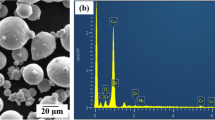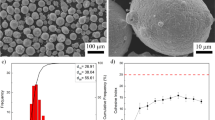Abstract
For a past few years, laser powder bed fusion (LPBF) process faced many issues such as cavity creation, unstable thermal capillary convection, and thermodynamic instability during the printing of Cu-Cr-Zr alloy. Hence, the important LPBF process variables such as exposure duration (ED) of 300, 400, and 500 µs; laser power (LP) of 370, 420, and 470 W; and overlap** percentage (OP) of 20, 40, and 60% needs to be examined based on the interactions of various combinations of parameters to fabricate a Cu-Cr-Zr alloy parts with reduced porosity, maximum ultimate tensile strength (UTS), and minimum nano-indentation depth (NID). Moreover, analytical studies were also performed based on the COmplex PRoportional ASsessment (COPRAS) approach. The proposed analytical approach shows better concurrence with the experimental observations. The optimal and initial variables obtained from the analytical and experimental approach were compared. The Cu-Cr-Zr alloy printed with optimal parameter settings possesses maximum UTS of 367 MPa and minimum NID of 321.51 nm. These enhanced results were mainly due to the occurrence of reduced porosity of 0.27%. Moreover, FESEM based fracture mechanism were investigated to study the propagation of cracks based on the defects formation.










Similar content being viewed by others
Data availability
The experimental datasets obtained from this research work and then the analysed results during the current study are available from the corresponding author on reasonable request.
References
Jiang Q, Zhang P, Yu Z, Shi H, Wu D, Yan H, Ye X, Lu Q, Tian Y (2021) A review on additive manufacturing of pure copper. Coatings 11. https://doi.org/10.3390/coatings11060740
Tran TQ, Chinnappan A, Lee JKY, Loc NH, Tran LT, Wang G, Kumar VV, Jayathilaka WADM, Ji D, Doddamani M, Ramakrishna S (2019) 3D printing of highly pure copper. Metals (Basel) 9:12–20. https://doi.org/10.3390/met9070756
Jadhav SD, Dhekne PP, Dadbakhsh S, Kruth JP, Van Humbeeck J, Vanmeensel K (2020) Surface modified copper alloy powder for reliable laser-based additive manufacturing. Addit Manuf 35:101418. https://doi.org/10.1016/j.addma.2020.101418
Jamil IR, Mustaquim AM, Islam M, Thakur MSH, Hasan MN (2023) Effect of powder bed fusion process parameters on microstructural and mechanical properties of FeCrNi MEA: an atomistic study. Met Mater Int 29:659–673. https://doi.org/10.1007/s12540-022-01263-z
Patel M, Aggarwal A, Kumar A (2023) Investigation of cracking susceptibility and porosity formation and its mitigation techniques in laser powder bed fusion of Al 7075 alloy. Met Mater Int 29:2358–2373. https://doi.org/10.1007/s12540-023-01387-w
Singh A, Caprio L, Previtali B, Demir AG (2022) Processability of pure Cu by LPBF using a ns-pulsed green fiber laser. Opt Laser Technol 154. https://doi.org/10.1016/j.optlastec.2022.108310
Tan C, Chew Y, Bi G, Wang D, Ma W, Yang Y, Zhou K (2021) Additive manufacturing of steel–copper functionally graded material with ultrahigh bonding strength. J Mater Sci Technol 72:217–222. https://doi.org/10.1016/j.jmst.2020.07.044
Malý M, Koutný D, Pantělejev L, Pambaguian L, Paloušek D (2022) Effect of high-temperature preheating on pure copper thick-walled samples processed by laser powder bed fusion. J Manuf Process 73:924–938. https://doi.org/10.1016/j.jmapro.2021.11.035
Silbernagel C, Gargalis L, Ashcroft I, Hague R, Galea M, Dickens P (2019) Electrical resistivity of pure copper processed by medium-powered laser powder bed fusion additive manufacturing for use in electromagnetic applications. Addit Manuf 29:100831. https://doi.org/10.1016/j.addma.2019.100831
Jadhav SD, Fu D, Deprez M, Ramharter K, Willems D, Van Hooreweder B, Vanmeensel K (2020) Highly conductive and strong CuSn0.3 alloy processed via laser powder bed fusion starting from a tin-coated copper powder. Addit Manuf 36:101607. https://doi.org/10.1016/j.addma.2020.101607
Qu S, Ding J, Fu J, Fu M, Zhang B, Song X (2021) High-precision laser powder bed fusion processing of pure copper. Addit Manuf 48:102417. https://doi.org/10.1016/j.addma.2021.102417
Artzt K, Siggel M, Kleinert J, Riccius J, Requena G, Haubrich J (2020) Pyrometric-based melt pool monitoring study of CuCr1Zr processed using L-PBF. Materials (Basel) 13:1–22. https://doi.org/10.3390/ma13204626
Sinico M, Jadhav SD, Witvrouw A, Vanmeensel K, Dewulf W (2021) A micro-computed tomography comparison of the porosity in additively fabricated cucr1 alloy parts using virgin and surface-modified powders. Materials 14(8):1995. https://doi.org/10.3390/ma14081995
Abdelhafiz M, Emadi A, Elbestawi MA (2023) On the fabrication of high-performance additively manufactured copper winding using laser powder bed fusion. Materials (Basel) 16:4694. https://doi.org/10.3390/ma16134694
Jeyaprakash N, Yang CH, Ramkumar KR (2021) Microstructural, mechanical and wear behaviour of Inconel-718 produced through laser-powder bed-fused additive manufacturing. Mater Sci Technol (United Kingdom) 37:326–337. https://doi.org/10.1080/02670836.2021.1893457
Jadhav SD, Goossens LR, Kinds Y, Van Hooreweder B, Vanmeensel K (2021) Laser-based powder bed fusion additive manufacturing of pure copper. Addit Manuf 42. https://doi.org/10.1016/j.addma.2021.101990
Liu Y, Zhang J, Tan Q, Yin Y, Liu S, Li M, Li M, Liu Q, Zhou Y, Wu T, Wang F, Zhang MX (2021) Additive manufacturing of high strength copper alloy with heterogeneous grain structure through laser powder bed fusion. Acta Mater 220:117311. https://doi.org/10.1016/j.actamat.2021.117311
Ma Z, Zhang K, Ren Z, Zhang DZ, Tao G, Xu H (2020) Selective laser melting of Cu–Cr–Zr copper alloy: parameter optimization, microstructure and mechanical properties. J Alloys Compd 828:154350. https://doi.org/10.1016/j.jallcom.2020.154350
Sun F, Liu P, Chen X, Zhou H, Guan P, Zhu B (2020) Mechanical properties of high-strength cu–cr–zr alloy fabricated by selective laser melting. Materials (Basel) 13:1–16. https://doi.org/10.3390/ma13215028
Jiang LY, Schmid F, Nassr M, Fadavian H, Mostaan MA, Semirumi DT (2023) Fabrication of porous polymeric-based scaffold for dental tissue repair in fracture healing: RVE simulation and ANN optimization. Mater Sci Eng B 297:116770. https://doi.org/10.1016/j.mseb.2023.116770
Jeyaprakash N, Yang CH, Ramkumar KR (2021) Correlation of microstructural evolution with mechanical and tribological behaviour of SS 304 specimens developed through SLM technique. Met Mater Int 27:5179–5190. https://doi.org/10.1007/s12540-020-00933-0
Fang X, **a W, Wei Q, Wu Y, Lv W, Guo W (2021) Preparation of Cu-Cr-Zr alloy by laser powder bed fusion: parameter optimization, microstructure, mechanical and thermal properties for microelectronic applications. Metals (Basel). 11. https://doi.org/10.3390/met11091410.
Nelson K, Kelly CN, Gall K (2022) Effect of stress state on the mechanical behavior of 3D printed porous Ti6Al4V scaffolds produced by laser powder bed fusion. Mater Sci Eng B Solid-State Mater Adv Technol 286:116013. https://doi.org/10.1016/j.mseb.2022.116013
Jeyaprakash N, Kumar MS, Yang C (2023) Enhanced nano-level mechanical responses on additively manufactured Cu-Cr-Zr copper alloy containing Cu2O nano precipitates. J Alloys Compd 930:167425. https://doi.org/10.1016/j.jallcom.2022.167425
Murugesan SK, Natarajan J, Yang CH, Vijayananth K (2023) A synergistic impact of LPBF process parameters on attaining a defect-free Cu-Cr-Zr alloy parts: an analytical and experimental study. Int J Adv Manuf Technol 128:3507–3529. https://doi.org/10.1007/s00170-023-12179-2
Jeyaprakash N, Yang CH, Kumar MS (2022) Influence of coherent intermetallic nano-precipitates on the nano-level mechanical and tribological properties of the laser-powder bed fused Scalmalloy. Mater Charact 193:112269. https://doi.org/10.1016/j.matchar.2022.112269
Li J, Kuai Z, Li Z, Liu B, Chen Y, Lu S, Nie Y, Yang Z (2022) Effects of process parameters on the relative density and properties of CuCrZr Alloy produced by selective laser melting. Metals (Basel) 12. https://doi.org/10.3390/met12050701
Hu Z, Du Z, Yang Z, Yu L, Ma Z (2022) Preparation of Cu–Cr–Zr alloy by selective laser melting: role of scanning parameters on densification, microstructure and mechanical properties. Mater Sci Eng A 836:142740. https://doi.org/10.1016/j.msea.2022.142740
Jeyaprakash N, Saravana Kumar M, Yang CH, Cheng Y, Radhika N, Sivasankaran S (2024) Effect of microstructural evolution during melt pool formation on nano-mechanical properties in LPBF based SS316L parts. J Alloys Compd 972:172745. https://doi.org/10.1016/j.jallcom.2023.172745
Acknowledgements
We are grateful for the support from the Ministry of Science and Technology, Taiwan for providing the financial support.
Author information
Authors and Affiliations
Corresponding author
Ethics declarations
Competing interests
The authors declare no competing interests.
Additional information
Publisher's Note
Springer Nature remains neutral with regard to jurisdictional claims in published maps and institutional affiliations.
Rights and permissions
Springer Nature or its licensor (e.g. a society or other partner) holds exclusive rights to this article under a publishing agreement with the author(s) or other rightsholder(s); author self-archiving of the accepted manuscript version of this article is solely governed by the terms of such publishing agreement and applicable law.
About this article
Cite this article
Murugesan, S.K., Natarajan, J. & Yang, CH. Enhancement of strength and ductility in LPBFed Cu-Cr-Zr alloy by combined parametric approach. Int J Adv Manuf Technol 130, 2999–3015 (2024). https://doi.org/10.1007/s00170-023-12874-0
Received:
Accepted:
Published:
Issue Date:
DOI: https://doi.org/10.1007/s00170-023-12874-0




